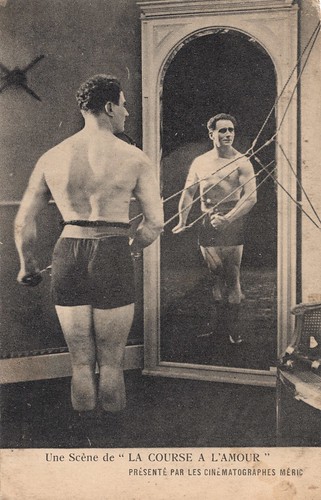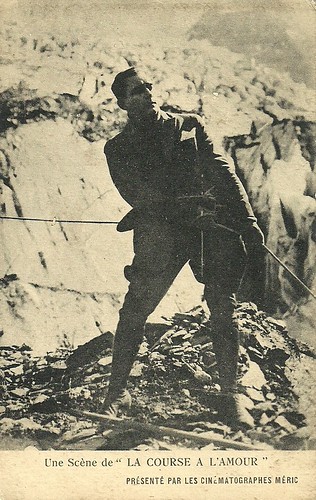
French postcard by Les Cinématographes Méric. Photo: publicity still of Ausonia (Mario Guaita) in the French silent film La course à l'amour/Love on the Run (Paul Barlatier, Charles Keppens, 1924).

French postcard by Les Cinématographes Méric. Photo: publicity still of the French silent film La course à l'amour (Paul Barlatier, Charles Keppens, 1924) with Ausonia and Gina Relly.
Sympathetic comedy
In La course à l'amour/Love on the Run (Paul Barlatier, Charles Keppens, 1924) is described by the Dictionnaire du cinéma français des années vingt as a 'sympathetic comedy'.
Three men compete for one woman. One of the men was played by Édouard Mathé, the star of the successful serials Les vampires/The Vampires (Louis Feuillade, 1915) and Judex (Louis Feuillade, 1916). His character is a suave daredevil, who can even fly a plane.
His two competitors are the Italian strongman Mario Guaita aka Ausonia, and Léon Lorin, who is the comical sidekick as the Marquis de Morte-Saisons.
The three men bet for the attention of Mary Gleane, daughter of a wealthy American. Mary is played by Gina Relly, who plays a double role in the film. Unknowingly to the men, Mary involves her twin sister Jenny in the bet.
The suitors, Mary, Jenny and Mary's maid Betty (Jeanne Rollette) all travel from Nice to Évian. The winner of the bet is the man who hold Mary's hand when she exits the car in Ëvian. By all means of transport - train, car, bus, plane and even a bike - the group travels across the Alps. Each man thinks he is traveling with Mary, but the three women constantly outsmart the men.
La course à l'amour is more than a romantic comedy. It is also a travelogue from the south of France to the Alps, which shows the splendour of the French countryside. The film was really shot on location between Nice and Évian.
It was a silent black and white production by Lauréa Films, a regional film production company that produced several local films in a studio of the Red Cross since 1920. Head of productions of Lauréa Film was Paul Barlatier, who was one of the directors and script-writer of this film. His co-director was former actor Charles Keppens.
La Course à l'amour was not the first film made with this title. Wikipedia mentions that in 1912 there had been an early short silent version, La Course à l'amour (Jean Durand, 1912) with comic Onésime and Gaston Modot. It probably had a different script.

French postcard by Les Cinématographes Méric. Photo: publicity still of La course à l'amour (Paul Barlatier, Charles Keppens, 1924) with Ausonia.

French postcard by Les Cinématographes Méric. Photo: publicity still of La course à l'amour (Paul Barlatier, Charles Keppens, 1924).
Muscleman
The athletic Ausonia got the most attention on the postcards made for La course à l'amour. The Italian had had his international breakthrough with Spartaco/Spartacus (Enrico Vidal, 1913) and in the following decade he became a major actor in the Italian forzuto (strong men) genre.
This genre started with the popular strong man Maciste (Bartolomeo Pagano) in the classic spectacle Cabiria (Giovanni Pastrone, 1914). The forzuto can be seen as a forerunner of the Peplum genre of the 1950s and 1960s and Hollywood's superhero films of later decades.
In the early 1920s, Ausonia moved to Marseille, where he made La course à l'amour (1924) and a few other films and where he ran a cinema.
Despite the series of postcards and Ausonia's impressive muscles, the film was probably not a success. It was the final film for co-director Charles Keppens and for lead actor Édouard Mathé. Also for his co-star Gina Relly, it was one of her last films. Her impressive film career ended two years later.
Lauréa Film ceased its activities and of Paul Barlatier was not heard again.

French postcard by Les Cinématographes Méric. Photo: publicity still for La course à l'amour (Paul Barlatier, Charles Keppens, 1924) with Léon Lorin and Gina Relly.
Sources: Dictionnaire du cinéma français des années vingt (French) Wikipedia (French) and IMDb.
No comments:
Post a Comment